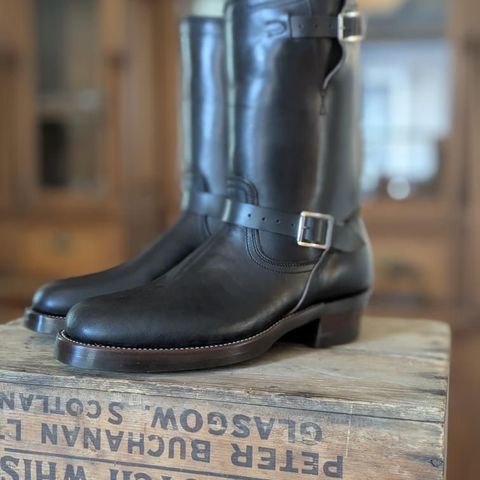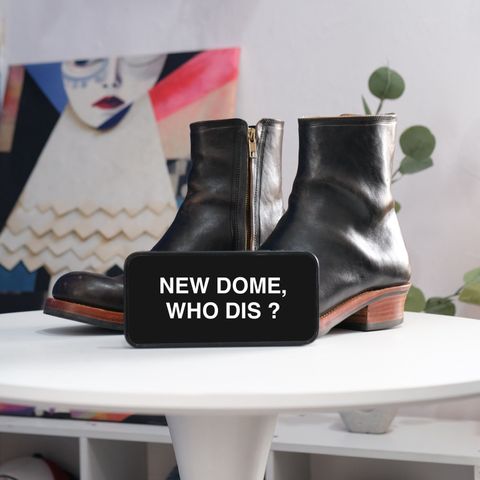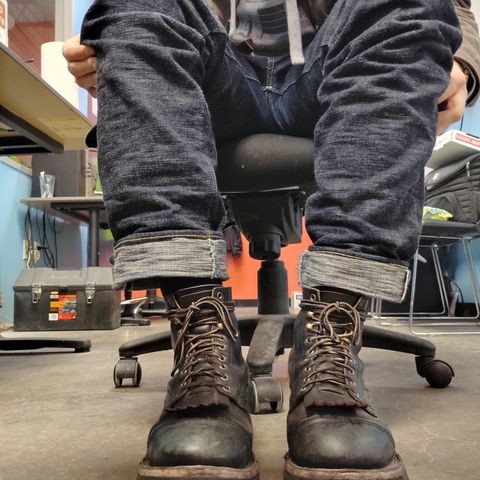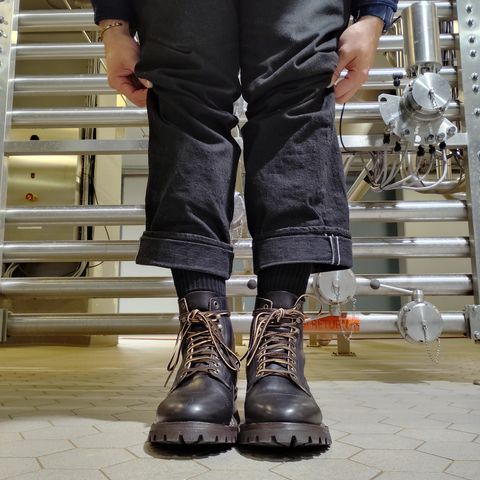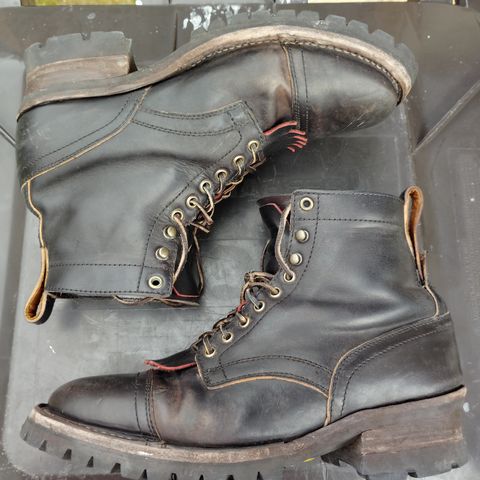Maryam Natural Horsebutt Overdyed Black
Leather ColorAbout
Maryam Natural Horsebutt Overdyed Black is a premium teacore leather that combines the exceptional durability of horsebutt with the dramatic aging characteristics of overdyed vegetable-tanned leather. This specialty leather begins as natural vegetable-tanned horsebutt from Maryam Tannery and receives an additional black dye treatment, creating a striking leather that reveals warm brown undertones through natural wear and aging, resulting in the highly coveted teacore effect.
About
Maryam Natural Horsebutt Overdyed Black is a premium teacore leather that combines the exceptional durability of horsebutt with the dramatic aging characteristics of overdyed vegetable-tanned leather. This specialty leather begins as natural vegetable-tanned horsebutt from Maryam Tannery and receives an additional black dye treatment, creating a striking leather that reveals warm brown undertones through natural wear and aging, resulting in the highly coveted teacore effect.
Tannery Heritage
Maryam Tannery, located in Santa Croce sull'Arno in Tuscany, Italy, represents centuries of Italian leather-making tradition. The tannery's approach combines time-honored vegetable tanning methods with selective overdyeing processes to create complex, multi-layered leathers. Using natural tannins extracted from tree bark and plant materials, Maryam's slow tanning process creates the foundation that makes exceptional overdyed leathers possible, ensuring each hide develops the depth and character necessary for superior teacore development.
Overdyeing Process
The overdyeing process begins with naturally tanned horsebutt leather that has already undergone Maryam's traditional vachetta treatment. An additional layer of black dye or pigment is applied to the leather surface, creating a deep, rich black exterior while preserving the natural brown vegetable-tanned leather beneath. This removable surface treatment, known as "asportabile," creates a thin but effective color layer that will gradually wear away through use and exposure.
The overdyeing technique differs from traditional dyeing by adding color to already-finished leather rather than incorporating color during the tanning process. This approach preserves the underlying natural characteristics while creating the foundation for dramatic color evolution through aging.
Teacore Characteristics
The term "teacore" derives from the Japanese "茶芯" (cha shin), directly referencing the tea-like brown hues that lie at the leather's core. Maryam's natural horsebutt overdyed black exemplifies classic teacore leather, featuring a deep black surface that conceals the warm brown vegetable-tanned foundation beneath. This dual-color construction creates one of the most visually dramatic aging processes in premium leather goods.
The teacore effect occurs as the thin black overdye layer gradually wears away through friction, stretching, and environmental exposure, revealing the natural brown leather core. This process creates unique wear patterns that reflect the specific usage and handling characteristics of each individual item.
Horsebutt Foundation Quality
The horsebutt sections selected for overdyeing come from areas of the hide that, while not qualifying for shell cordovan production, still possess the exceptional density and fiber structure that make horsebutt legendary. These sections feature incredibly tight fiber construction that provides exceptional durability while maintaining the flexibility necessary for comfortable use in demanding applications.
The vegetable tanning process preserves and enhances these natural characteristics, creating a leather that not only develops beautiful patina but also withstands the stresses that cause the overdye layer to wear away naturally, ensuring the teacore effect develops properly over time.
Aging and Patina Development
The aging process of overdyed black horsebutt creates one of the most striking visual transformations in leather goods. Initially appearing as uniform deep black, the leather begins showing brown undertones within weeks to months of regular use. Areas subject to frequent handling, bending, or friction develop patina more rapidly, creating organic wear patterns that cannot be replicated artificially.
The brown undertones emerging through the black surface create rich color variations ranging from golden honey to deep chocolate brown, depending on the specific areas of wear and environmental exposure. High-stress areas such as boot toe boxes, wallet creases, and jacket elbows typically show the most dramatic color transitions.
Factors Influencing Teacore Development
Multiple factors influence how quickly and dramatically the teacore effect develops. Physical stress from bending, stretching, and friction accelerates the wearing away of the black surface layer. Environmental factors such as sunlight, moisture exposure, and temperature fluctuations also contribute to the aging process.
The underlying vegetable-tanned leather continues to develop its own patina simultaneously with the overdye wearing away, creating complex interactions between surface color change and deeper leather maturation. This dual-aging process ensures that teacore leather continues to evolve visually throughout its entire lifespan.
Timeline and Visual Evolution
Visible teacore effects typically begin appearing within the first few months of regular use, starting as subtle brown hints in high-wear areas. The most dramatic changes occur during the first year to eighteen months, when the contrast between black surface and brown core creates striking visual patterns.
The teacore development process continues for years, with subtle changes occurring as both the remaining overdye and underlying vegetable-tanned leather continue to age. Items that receive daily use will show more rapid and pronounced teacore development than those used occasionally.
Applications and Usage
Overdyed black horsebutt leather excels in applications where dramatic visual evolution is desired alongside exceptional durability. Boot manufacturers particularly value this leather for its ability to develop unique character while maintaining structural integrity under demanding conditions. The teacore effect creates visually striking footwear that tells the story of its wear through color changes.
Leather goods such as jackets, wallets, and bags made from this material become increasingly distinctive with use, developing character that reflects the owner's lifestyle and usage patterns. The combination of horsebutt durability and teacore aging creates items that improve both functionally and aesthetically over time.
Care and Maintenance
Overdyed black horsebutt requires minimal intervention to achieve optimal teacore development. Excessive conditioning can slow the natural wearing process that creates the teacore effect, so treatments should be used sparingly and only when necessary to maintain leather health. The vegetable-tanned foundation responds well to traditional leather conditioning products when application is needed.
Understanding that color change is the desired outcome helps guide care decisions. Rather than attempting to preserve the original black appearance, care routines should focus on maintaining leather health while allowing natural aging processes to proceed unhindered, resulting in the most authentic and striking teacore development.
References
Maryam Tannery Official Website - Company overview, tanning processes, and heritage information
RM Leather Supply - Maryam Horse Butts - Official North America distributor specifications
Himel Bros. Leather - What is Teacore Leather - Professional perspective on teacore leather properties and applications
Rivet & Hide - Teacore Leather Guide - Comprehensive guide to teacore leather characteristics and care
Shangri-la Heritage - Maryam Black Tea-Core Horsehide - Real-world example of Maryam teacore leather and aging descriptions
Oak Street Bootmakers - Brown Overdye Natural Veg Tan - Example of overdye process on natural vegetable-tanned leather
Galen Leather - Vegetable Tanned Leather - Quality characteristics and benefits of vegetable-tanned leather
